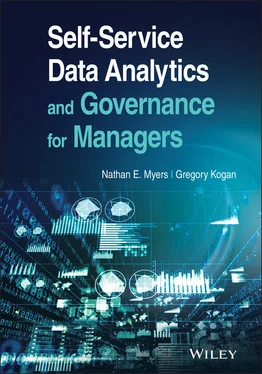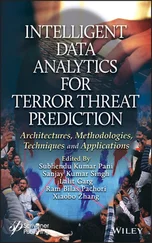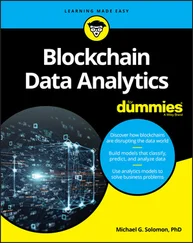The benefits of self-service data analytics tools include increased process stability, reduced dependency on the often over-subscribed technology function, improved time-to-market – and the instant relief as capacity is recaptured through process automation. Removing the technology function from the critical path is an important end that has led to a raft of self-service and user-configurable tools spanning processing and reporting. Data democratization, or the widespread availability and accessibility of critical datasets throughout organizations, is a significant driver behind the growth of self-service data analytics, as operators sitting directly on top of business processes are well-placed to unlock data value if provided with the tools and capabilities to harness it. Perhaps chiefly, work that was previously unstructured, risky, and manual-intensive can now be structured in a tool, emulating system-driven processing. Laborious and time-consuming spreadsheet processing can now be easily replaced with tactical application-driven processing, leading to time savings and efficiency.
We all know that systems (“big” automation) are integral to nearly every job across nearly every industry, much as mechanization was a game-changer for manufacturing during the Industrial Revolution. In our digital and information age, where vast data is captured, stored, transformed, and processed for use to inform business decisions, core technology systems offer both coded processing and considerable mature technology governance, tied up with a bow and a ribbon. Systems are a central hub for structured development – offering data storage and processing operations, long lists of features and functionality, they offer user experience (UX) styles, and perhaps a rich reporting suite – but importantly, they quietly serve unnoticed as a centralized funnel around which to build internal controls and governance to ensure the accuracy and stability of processing.
The fact that systems are widely subscribed to in an organization ties many operators to enveloping control frameworks built around them. Thanks to mature system governance, many systems are designed with embedded internal controls such as those that ensure appropriate user entitlements, automatic system reconciliations and check totals to ensure data integrity, and perhaps even workflows providing for required supervisory approvals. Critically, many companies already enforce robust change governance around technology deliveries, including the mandated production of key project development artifacts such as documented requirements, evidence of test scripts and testing results, evidence of sign-off, and post-implementation reviews following a release. However, with the development decentralization that results from putting low-code, no-code tooling in the hands of users throughout the organization, governance frameworks built around systems will ignore an increasing segment of solution development and processing. This is one factor leading to a rift we are referring to in this book as the self-service data analytics governance gap.
This book is unique, because it is written not for data scientists or those with PhDs in statistics, mathematics, or neural sciences. It is not written for machine learning experts or AI specialists. This book is written for managers at large organizations, where there are pockets of operators – or likely entire functions – performing manual processes in spreadsheets. This edition will be valuable for managers that are increasingly under pressure to cut costs, produce more, and overall to do more with fewer hands. We will introduce process discovery methods to identify manual pain points and opportunities to capture efficiencies across functions, we will demonstrate how to size and cost these efforts, how to quantify the benefits cases, and how best to compare projects to assess priority. We will showcase prominent tools in action, as we take our readers through case studies featuring common use cases that they are likely to encounter in their own processing plants. The process consistency and stability benefits, which result as manual work done outside of systems is structured in tools, will be crystallized for the reader. Further, the reader will walk away convinced of the need for an overarching governance framework to protect the value created by the analytics portfolio. Our readers will surely have heard about AI and some of the disciplines within it, they may have heard about data analytics and understand that it is transformative, but they will benefit from a clear introduction to the language of data analytics, and they will benefit from simple demonstrations of emergent data analytics technologies. Finally, they will be armed with ideas on how to influence the approach, the course, and the speed of their organization's digital progression.
A subset of readers may be further along the digital transformation journey at their respective organizations. They have been exposed to common use cases for analytics tooling, they may have assembled a project portfolio, or perhaps even adopted self-service tooling across their organizations. These readers will benefit as the basics are clarified and reinforced, and they will appreciate the pains we have taken to present complex subject matter colloquially, as though we are explaining it to a trusted friend. Perhaps readers have already witnessed risks introduced by the unchecked proliferation of self-service analytics, in an environment where fragmented legacy governance frameworks better suited to system development have failed to close the coverage gap. In months of research prior to writing this book, your authors failed to identify an existing comprehensive governance framework suited entirely for data analytics or self-service data analytics portfolios. We resolved, therefore, to examine the existing body of frameworks and guidance and extend key principals to create and present an actionable governance runbook to optimize control over data analytics portfolios in this book – the first of its kind. In an era of increased accountability to internal auditors, external auditors, and regulators, we want to provide readers with the means to protect portfolio value through risk identification and mitigation and prepare you to meet the inevitable scrutiny head-on.
In the following chapters, we will take a practical approach to familiarizing readers with data analytics technologies and practices: we will discuss the rise of big data, whether from the internet of things (IoT) or the increasing body of digitized text from optical character recognition (OCR) or intelligent character recognition (ICR), the large data arrays that can be interacted with through natural language processing (NLP), subscribed to with ready-made application programming interfaces (APIs), and visualized with customizable interactive dashboarding solutions. From there, we will move on to explain the ways processing has evolved to digest the increasing body of available data. We will highlight decentralized, crowd-sourced distributed ledger technology (DLT) and blockchain, as well as cloud computing as a shift in the consumption model for storage, data subscription, and software. We will define AI as the nebulous pursuit of technologies that may ultimately emerge to emulate human thinking, capabilities, and interactions, encompassing all of the disciplines above – and more.
Having provided a backdrop to ease readers into our key topics, we will discuss data analytics disciplines that are rapidly evolving to supplant routinized manual spreadsheet operations. We will walk through robotic process automation (RPA) use cases and describe how RPA is being widely adopted to capture efficiency for (repetitive and stable) data capture and manipulation. We will briefly touch on machine learning and predictive analytics as advanced areas of analytics. Likely, the most immediate opportunity to transform processing will come about from the widespread adoption of self-service data analytics, which will emerge as a theme throughout this book. Putting low-code/no-code capabilities directly into the hands of process owners to automate extract, transform, and load (ETL) steps and to perform formulaic calculations, extensions, and comparisons will lead to a growth pattern and a pace of change never before encountered in the legacy system development environment. We will further devote a chapter to demonstrating the use of Alteryx, an increasingly prevalent tool that is rapidly transforming data analysis, processing, and reporting, to bring you firmly aboard the journey.
Читать дальше












